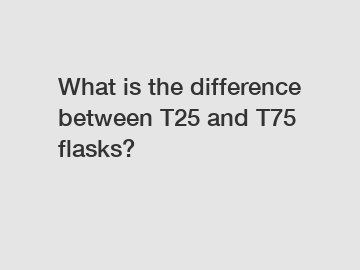What is the difference between T25 and T75 flasks?
When it comes to cell culture techniques, using the right laboratory equipment is essential for achieving successful results. Two common items used in cell culture laboratories are T25 and T75 flasks. These flasks are designed for culturing adherent cells, but their sizes and shapes differ. Understanding the differences between T25 and T75 flasks can help researchers choose the right vessel for their specific cell culture needs.
Size and Capacity.
T25 flasks and T75 flasks are named based on their approximate surface area in square centimeters. T25 flasks have a surface area of 25 square centimeters, while T75 flasks have a surface area of 75 square centimeters. The larger surface area of the T75 flask allows for the growth of a greater number of cells compared to the T25 flask. T75 flasks are commonly used for high-density cell culture, whereas T25 flasks are suitable for smaller scale experiments or when working with limited cell numbers.

Shape and Design.
In addition to differences in size, T25 and T75 flasks also have different shapes and designs. T25 flasks typically have a taller, narrower shape, which can be beneficial for mixing or shaking cultures. On the other hand, T75 flasks have a shorter, wider shape that allows for easier access to the cells during media changes or subculturing. The design of the flask can impact cell growth and morphology, so choosing the right shape is important depending on the specific requirements of the experiment.
Usage and Applications.
The choice between T25 and T75 flasks often depends on the scale of the cell culture experiment and the specific requirements of the cells being cultured. T25 flasks are commonly used for routine maintenance of cell lines, small-scale experiments, or when working with limited cell numbers. T25 flasks are also suitable for experiments that require multiple culture vessels to be set up simultaneously.
On the other hand, T75 flasks are preferred for high-density cell culture, scale-up experiments, and when a large number of cells are required for downstream applications. The larger surface area of T75 flasks allows for higher cell yields and better growth kinetics, making them ideal for producing large quantities of cells for experiments or applications that require a higher cell density.
Choosing the Right Flask.
When deciding between T25 and T75 flasks, researchers should consider their specific cell culture needs and the requirements of the experiment. Factors such as cell type, growth characteristics, experimental scale, and downstream applications should all be taken into account when selecting the appropriate flask. Using the right flask can improve cell growth, viability, and overall experimental outcomes.
In conclusion, T25 and T75 flasks are essential tools in cell culture laboratories, each with its own advantages and applications. Understanding the differences in size, shape, and design of T25 and T75 flasks can help researchers make informed decisions when selecting the appropriate vessel for their cell culture experiments. By choosing the right flask, researchers can optimize cell growth, streamline experimental processes, and achieve reliable and reproducible results in their studies.
Contact us today for more information on T25 and T75 flasks or to discuss your cell culture needs with our team of experts.
For more information, please visit t175 flasks, uses of conical flask in laboratory, roller bottles sizes.



Comments
0